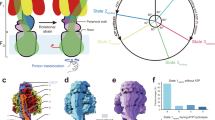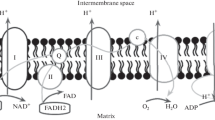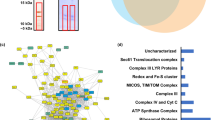Abstract
The yeast mitochondrial ATP synthase is a rotary molecular machine primarily responsible for the production of energy used to drive cellular processes. The enzyme complex is composed of 17 different subunits grouped into a soluble F1 sector and a membrane-embedded F0 sector. The catalytic head of the F1 sector and the membrane integrated motor module in the F0 sector are connected by two stalks, the F1 central stalk and the F0 peripheral stalk. Proton translocation through the F0 motor module drives the rotation of the subunit 910-ring that generates torque which is transmitted to the calaytic head through the γ subunit of the central stalk. The rotation of the γ subunit causes changes in conformation of the catalytic head which leads to the synthesis of ATP. Biogenesis of the enzyme involves modular assembly of polypeptides of dual genetic origin, the nuclear and the mitochondrial genomes. Most of the yeast ATP synthase subunits are encoded by the genome of the nucleus, translated on cytosolic ribosomes and imported into mitochondria. In the mitochondria, the enzyme forms a dimer which contributes to the formation of cristae, a characteristic of mitochondrial morphology. Substantial progress has recently been made on the elucidation of detailed stucture, function and biogenesis of yeast mitochondrial ATP synthase. The recent availability of high-resolution structure of the complete monomeric form, as well as the atomic model for the dimeric F0 sector, has advanced the understanding of the enzyme complex. This review is intended to provide an overview of current understanding of the molecular structure, catalytic mechanism, subunit import into mitochondria, and the subunit assembly into the enzyme complex. This is important as the yeast mitochondrial ATP synthase may be used as a model for understanding the corresponding enzyme complexes from human and other eukaryotic cells in physiological and diseased states.






Similar content being viewed by others
References
Abraham JP, Leslie AGW, Lutter R, Walker JE (1994) Structure at 2.8 Å resolution of F1-ATPase from bovine heart mitochondria. Nature 370:621–628
Anselmi C, Davies KM, Faraldo-Gómez JD (2018) Mitochondrial ATP synthase dimers spontaneously associate due to a long-range membrane-induced force. J Gen Phys 150:763–770
Arnold I, Pfeiffers K, Neupert W, Stuart RA, Schagger H (1999) ATP synthase of yeast mitochondria. Isolation of subunit j and disruption of the ATP18 gene. J Biol Chem 174:36–40
Arselin G, Vaillier J, Graves PV, Velours J (1996) ATP synthase of yeast mitochondria. Isolation of the subunit h and disruption of the ATP14 gene. J Biol Chem 271:20284–20290
Artika IM (2007) Structural and functional analysis of FLAG tagged-subunit 8 of yeast Saccharomyces cerevisiae mitochondrial ATP synthase. Microbiol Indones 1:33–36
Artika IM (2009) Membrane topology of subunit 8 variant of yeast Saccharomyces cerevisiae mitochondrial ATP synthase. Microbiol Indones 3:37–41
Attardi G, Schatz G (1988) Biogenesis of mitochondria. Annu Rev Cell Biol 4:289–333
Backes S, Hess S, Boos F, Woellhaf MW, Gödel S, Jung M, Mühlhaus T, Herrmann JM (2018) Tom70 enhances mitochondrial preprotein import efficiency by binding to internal targeting sequences. J Cell Biol 217:1369–1382
Bateson MG, Devenish RJ, Nagley P, Prescott M (1999) Single copies of subunit b, oligomycin sensitivity conferring protein and d are present in the S. cerevisiae mitochondrial ATP synthase. J Biol Chem 274:7462–7466
Boyer PD (1975) A model for conformational coupling of membrane potential and proton translocation to ATP synthesis and active transport. FEBS Lett 58:1–6
Boyer PD (1989) A perspective of the binding change mechanism for ATP synthesis. FASEB J 3:2164–2178
Cheng MY, Harlt F, Martin J, Pollock RA, Kalousek F, Neupert W et al (1989) Mitochondrial heat-shock protein hsp60 is essential for assembly of protein imported into yeast mitochondria. Nature 337:620–625
Cox GB, Devenish RJ, Gibson F, Howitt SM, Nagley P (1992) The structure and assembly of ATP synthase. In: Ernster L (ed) Molecular mechanism in bioenergetics. Elsevier, Amsterdam, pp 283–315
Craig EA (2018) Hsp70 at the membrane: driving protein translocation. BMC Biol 16:1–11
Cross RL (1992) The reaction mechanism of F1F0-ATP synthases. In: Ernster L (ed) Molecular mechanism in bioenergetics. Elsevier, Amsterdam, pp 317–330
Cross RL, Duncan TM (1996) Subunit rotation in F1F0-ATP synthases as a mean of coupling proton transport through F0 to the binding changes in F1. J Bioenerg Biomembr 28:403–408
Dabbeni-Sala F, Rai AK, Lippe, G (2012) F0F1 ATP synthase: A fascinating challenge for proteomics, proteomics - human diseases and protein functions, Prof. Tsz Kwong Man (Ed.), ISBN: 978-953-307-832-8, InTech, Available from: http://www.intechopen.com/books/proteomics-humandiseases-and-protein-functions/f0f1-atp-synthase-a-fascinating-challenge-for-proteomics. Accessed 30 June 2018
Dautant A, Velours J, Giraud MF (2010) Crystal structure of the Mg.ADP-inhibited state of the yeast F1c10-ATP synthase. J Biol Chem 285:29502–29510
Davies KM, Anselmi C, Wittig I, Faraldo-Gómez JD, Kühlbrandt W (2012) Structure of the yeast F1F0-ATP synthase dimer and its role in shaping the mitochondrial cristae. Proc Natl Acad Sci U S A 109:13602–13607
Devenish RJ, Prescott M, Roucou X, Nagley P (2000) Insights into ATP synthase assembly and function through the molecular genetic manipulation of subunits of the yeast mitochondrial enzyme complex. Biochim Biophys Acta 1458:428–442
Devenish RJ, Prescott M, Rodgers AJW (2008) The structure and function of mitochondrial F1F0-ATP synthase. Int Rev Cell Mol Biol 267:1–58
Dienhart M, Pfeiffer K, Schägger H, Stuart RA (2002) Formation of the yeast F1F0-ATP synthase dimeric complex does not require the ATPase inhibitor protein, Inh1. J Biol Chem 277:39289–39295
Faccenda D, Campanella M (2012) Molecular regulation of the mitochondrial F1F0-ATP synthase: physiological and pathological significance of the inhibitory factor 1 (IF1). Int J Cell Biol 2012:1–12
Fox TD (2012) Mitochondrial protein synthesis, import, and assembly. Genetics 192:1203–1234
Guo H, Bueler SA, Rubinstein JL (2017) Atomic model for the dimeric F0 region of mitochondrial ATPsynthase. Science 358:936–940
Hahn A, Parey K, Bublitz M, Mills DJ, Zickermann V, Vonck J, Kühlbrandt W, Meier T (2016) Structure of a complete ATP synthase dimer reveals the molecular basis of inner mitochondrial membrane morphology. Mol Cell 63:445–456
Hartl F, Pfanner N, Nicholson DW, Neupert W (1989) Mitochondrial protein import. Biochem Biophys Acta 988:1–45
Hauckle V, Lithgow T (1997) The first steps of protein import into mitochondria. J Bioenerg Biomembr 29:11–17
He J, Ford HC, Carrol J, Douglas C, Gonzales E, Ding S, Fearnley IM, Walker JE (2018) Assembly of the membrane domain of ATP synthase in human mitochondria. Proc Natl Acad Sci U S A 115:2988–2993
Junge W, Lill H, Engelbrecht S (1997) ATP synthase: an electrochemical transducer with rotatory mechanics. Trends Biol Sci 22:420–423
Kabaleeswaran V, Puri N, Walker JE, Leslie AGW, Mueller DM (2006) Novel features of the rotary catalytic mechanism revealed in the structure of yeast F1 ATPase. EMBO J 25:5433–5442
Kresge N, Simoni RD, Hill RL (2006) ATP synthesis and the binding change mechanism: the work of Paul D. Boyer. J Biol Chem 281:e18–e20
Kühlbrandt W (2019) Structure and mechanism of F-type ATP synthases. Annu Rev Biochem 88:21.1–21.35
Mitchell P (1961) Coupling of phosphorylation to electron and hydrogen transfer by a chemi-osmotic type of mechanism. Nature 191:144–148
Nagley P (1988) Eukaryote membrane genetics: the F0 sector of mitochondrial ATP synthase. Trends Genet 4:46–52
Noji H, Yasuda R, Yoshida M, Kinosita K (1997) direct observation of the rotation of F1-ATPase. Nature 386:299–302
Norais N, Prome D, Velours J (1991) ATP synthase of yeast mitochondria: characterization of subunit d and sequence analysis of the structural gene ATP7. J Biol Chem 266:16541–16549
Rak M, Gokova S, Tzagoloff A (2011) Modular assembly of yeast mitochondrial ATP synthase. EMBO J 30:920–930
Roucou X, Artika IM, Devenish RJ, Nagley P (1999) Bioenergetic and structural consequences of allotopic expression of subunit 8 of yeast mitochondrial ATP synthase: the hydrophobic character of residues 23 and 24 is essential for maximal activity and structural stability of the enzyme complex. Eur J Biochem 261:444–451
Rubinstein JL, Walker JE (2002) ATP synthase from Saccharomyces cerevisiae: location of the OSCP subunit in the peripheral stalk region. J Mol Biol 321:613–619
Rubinstein JL, Dickson VK, Runswick MJ, Walker JE (2005) ATP synthase from Saccharomyces cerevisiae: location of subunit h in the peripheral stalk region. J Mol Biol 345:513–520
Sebald W, Hoppe J (1981) Proteolipid subunit of ATP synthase complex. Curr Top Bioeneg 12:1–64
Senior AE, Weber J, Al-Shawi MK (1995) Catalytic mechanism of Escherichia coli F1-ATPase. Biochem Soc Trans 23:747–752
Sokol AM, Sztolsztener ME, Wasilewski M, Heinz E, Chacinska A (2014) Mitochondrial protein translocases for survival and wellbeing. FEBS Lett 588:2484–2495
Song J, Pfanner N, Becker T (2018) Assembling the mitochondrial ATPsynthase. Proc Natl Acad Sci U S A 115:2850–2852
Spannagel C, Vaillier J, Arselin G, Graves P, Velours J (1997) The subunit f of mitochondrial yeast ATP synthase. Characterization of the protein and disruption of the structural gene ATP17. Eur J Biochem 247:1111–1117
Srivastava AP, Luo M, Zhou W, Symersky J, Bai D, Chambers MG, Faraldo-Gómez JD, Liao M, Mueller DM (2018) High-resolution cryo-EM analysis of the yeast ATP synthase in a lipid membrane. Science 360:1–8
Stephens AN, Roucou X, Artika IM, Devenish RJ, Nagley P (2000) Topology and proximity relationships of yeast mitochondrial ATP synthase subunit 8 determined by unique introduced cysteine residues. Eur J Biochem 267:6443–6451
Stephens AN, Nagley P, Devenish RJ (2003) Each yeast mitochondrial F1F0-ATP synthase complex contains a single copy of subunit 8. Biochim Biophys Acta 1607:181–189
Stewart AG, Laming EM, Sobti M, Stock D (2014) Rotary ATPases: dynamic molecular machines. Curr Opin Struct Biol 25:40–48
Su CH, McStay GP, Tzagolof A (2014) Assembly of the rotor component of yeast mitochondrial ATP synthase is enhanced when Atp9p is supplied by Atp9p-Cox6p complexes. J Biol Chem 289:31605–31616
Symersky J, Osowski D, Walters DE, Mueller DM (2012a) Oligomycin frames a common drug-binding site in the ATP synthase. Proc Natl Acad Sci U S A 109:13961–13965
Symersky J, Pagadala V, Osowski D, Krah A, Meier T, Faraldo-Gómez JD, Mueller DM (2012b) Structure of the c10 ring of the yeast mitochondrial ATP synthase in the open conformation. Nat Struct Mol Biol 19:485–505
Ting SY, Schilke BA, Hayashi M, Craig EA (2014) Architecture of the TIM23 inner mitochondrial translocon and interactions with the matrix import motor. J Biol Chem 289:28689–28696
Tzagoloff A, Myers AM (1986) Genetics of mitochondrial biogenesis. Annu Rev Biochem 55:249–285
Vaillier J, Arselin G, Graves P, Carmougrand N, Velours J (1999) Isolation of supernumerary yeast ATP synthase subunit e and i. Characterization of subunit i and disruption of its structural gene ATP18. J Biol Chem 274:545–548
Wagner K, Perschil I, Fichter CD, van der Laan M (2010) Stepwise assembly of dimeric F1F0-ATP synthase in mitochondria involves the small Fo-subunits k and i. Mol Biol Cell 21:1494–1504
Wiedemann N, Pfanner N (2017) Mitochondrial machineries for protein import and assembly. Annu Rev Biochem 86:685–714
Xu T, Pagadala V, Mueller DM (2015) Understanding structure, function, and mutations in the mitochondrial ATP synthase. Microbial Cell 2:105–125
Zhou A, Rohou A, Schep DG, Bason JV, Montgomery MG, Walker JE et al (2015) Structure and conformational states of the bovine mitochondrial ATP synthase by cryo-EM. eLife 4:e10180. https://doi.org/10.7554/eLife.10180
Acknowledgements
This work was carried out without external funding support. The author thanks Dr. John Acton for his assistance at the manuscript stage.
Author information
Authors and Affiliations
Corresponding author
Additional information
Publisher’s note
Springer Nature remains neutral with regard to jurisdictional claims in published maps and institutional affiliations.
Rights and permissions
About this article
Cite this article
Artika, I.M. Current understanding of structure, function and biogenesis of yeast mitochondrial ATP synthase. J Bioenerg Biomembr 51, 315–328 (2019). https://doi.org/10.1007/s10863-019-09809-4
Received:
Accepted:
Published:
Issue Date:
DOI: https://doi.org/10.1007/s10863-019-09809-4




